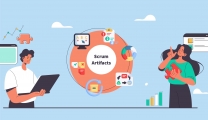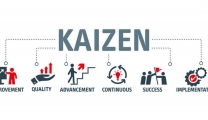1. Overview of the ASK model What is it?
Did you know about the ASK model? ASK is an acronym for Attitude - Knowledge - Skill. ASK is one of the standard models commonly used today for businesses. Its purpose is to evaluate employee competency based on 3 main factors: Attitude – Knowledge – Skills.
In particular, the ASK model is often applied to both personnel objects. It's job candidates and employees in your company.
For recruitment candidates, you can rely on the ASK assessment model to select people with relevant expertise for the vacancy. In addition, the factors of positive attitude and skills for serving the profession are also factors in assessing candidates' ranking in the recruitment list.
For employees in the company, the ASK model is of great significance to help companies classify employee levels according to qualifications, attitudes or skills. From there to make brilliant decisions in management, appointment decisions, division of work, rewards, etc.
2. What is the importance of ASK for HR and company?
2.1. Quantifying the HR skills gap
Skills gaps can be hard to ignore when they are causing major business detriments. Maybe you know the existence of staffing scale, you know the need to empower human resources. However, you may not yet know the means by which to quantify the skill gap between people.
A leader's decisions shape the future of the company. Therefore, it is certain that ASK is an effective human resource management method. The ASK model helps you to provide capacity assessment data, analyze the skill gap of personnel. From there, you can make informed decisions, confidently navigate and allocate the right people and jobs.
For candidates in the recruitment process, from the data on attitudes, knowledge, skills and divided into different levels, you can screen candidates. For employees in the company, you can categorize and evaluate the skill level of each employee.

2.2. Promote and improve
It is a fact that today organizations and companies are happening at an increasingly fast pace. Even as an employee is upskilled or retrained, some of their skills become obsolete.
The awareness of new trends, the skill to grasp the world around is extremely important. Therefore, the importance of the ASK Model is to determine the capacity of the individual in particular and the capacity of the enterprise in general.
Company is focused around re-skilling, assessing position-appropriate competencies and future-oriented. Capacity building in your organization begins when you create a cycle of evaluation, continual development, and re-evaluation of the skills and tasks you perform. It provides you with a continuously updated current picture of capacity at any time. This helps companies build an effective human resource management system.
Therefore, you need to develop an ASK employee evaluation method for your company. The purpose is to promote employee performance, streamline the personnel apparatus and improve every progress in the work process.
3. How to evaluate personnel using the ASK model
3.1 Assessment based on attitude
degree picking is the first element in the ASK model. Assessing personnel by attitude focuses on the following 5 levels:
- Totally focused
- Determination
- Care about
- Normal
- Do not care
3.2 Skill-based assessment
To evaluate the second factor in ASK includes the following levels:
- High skill
- Competently
- Practice
- Developing
- Begin
3.3 Knowledge-based assessment
This is the last element in the ASK model. In order to assess the capacity, attention should be paid to the following levels:
- Thoughtful
- Good understanding
- Basic level understanding
- Limited knowledge
- Without knowledge
4. 3 How to apply ASK in HRM
4.1. Develop a set of criteria for screening and recruiting personnel
Candidate screening is the process of reviewing incoming job applications. The purpose of the screening is to filter out a sufficient number of potential CVs and match the mission of the business set out from hundreds of thousands of applications. Screening candidates helps your company save costs and recruitment time.
To build a set of employee screening criteria, you need to keep the following in mind:
Professional qualification criteria: Depending on the requirements of the job, enterprises need to clearly define the criteria of professional qualifications that the vacancy is aimed at through degrees, professional certificates, etc.
Work experience criteria: Employers require work experience to increase with each rank. For example, professional staff have 1-3 years of experience, department heads will have 5-8 years of experience, and directors have more than 10 years of experience. Depending on the difficulty of the job to be recruited and the salary and welfare budget for the successful candidate, the enterprise determines the specific experience requirements for screening applications.
Critical Skills Criteria: Each position has different key skills and criteria. For example, communication skills, work arrangement skills, time management skills, logical reasoning skills, etc.
4.2. Building a capacity framework for internal human resource assessment
To build a competency framework for human resource assessment, you must first clarify what the purpose of the ASK framework is. If the construction purpose is different such as training, human resource development, compensation, salary payment, etc., it will lead to the selection of different levels.
We recommend the following structure to help you build your HR competency framework:
Competencies by role: Synthesized according to practical capabilities such as strategic thinking, self-management, leadership, etc.
Core competencies such as communication skills, problem-solving and processing skills, rhetoric skills, language skills, etc.
Professional competency framework associated with specific fields and specific positions of each employee. For example, sales skills, communication skills, programming skills, customer care skills, design skills, etc.
Behavioral competence is defined in terms of behavior, the purpose of which is to ensure applicability and proficiency. Managers can use support tools such as DISC tools, MBTI tools, etc.
4.3. Clear direction and development of personnel
However, to orient and develop personnel clearly, effectively and intelligently, you cannot follow the traditional path. That is, only definitions on paper, complex employee management processes from top to bottom, discrete and individual processing tools, etc. Therefore, you and your business need to optimize the process. ASK personnel management on smart software.
The growth of the organization depends on the progress of each individual. However, for employees to be able to do their jobs well, they need to be self-aware of the areas where they are lacking. Especially the person working as a human resource manager must have the most overview of the skills gap and tasks and roles.












Replies to This Discussion